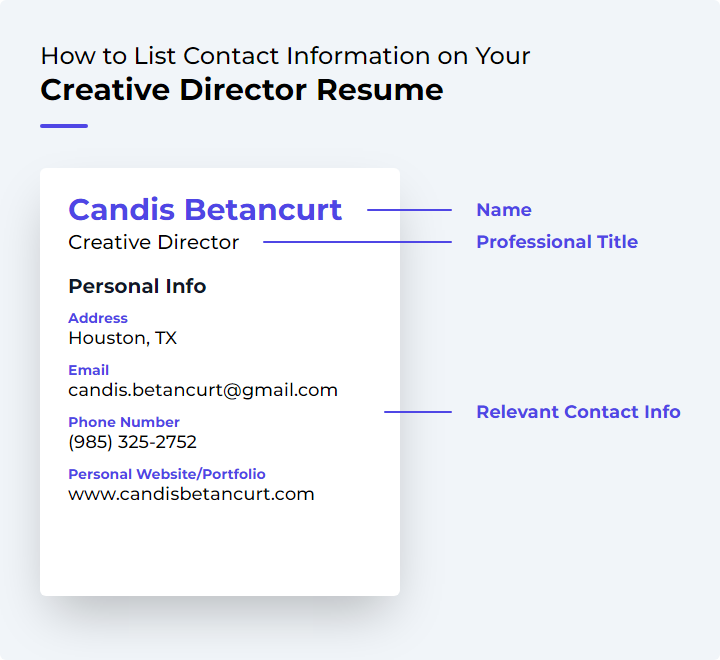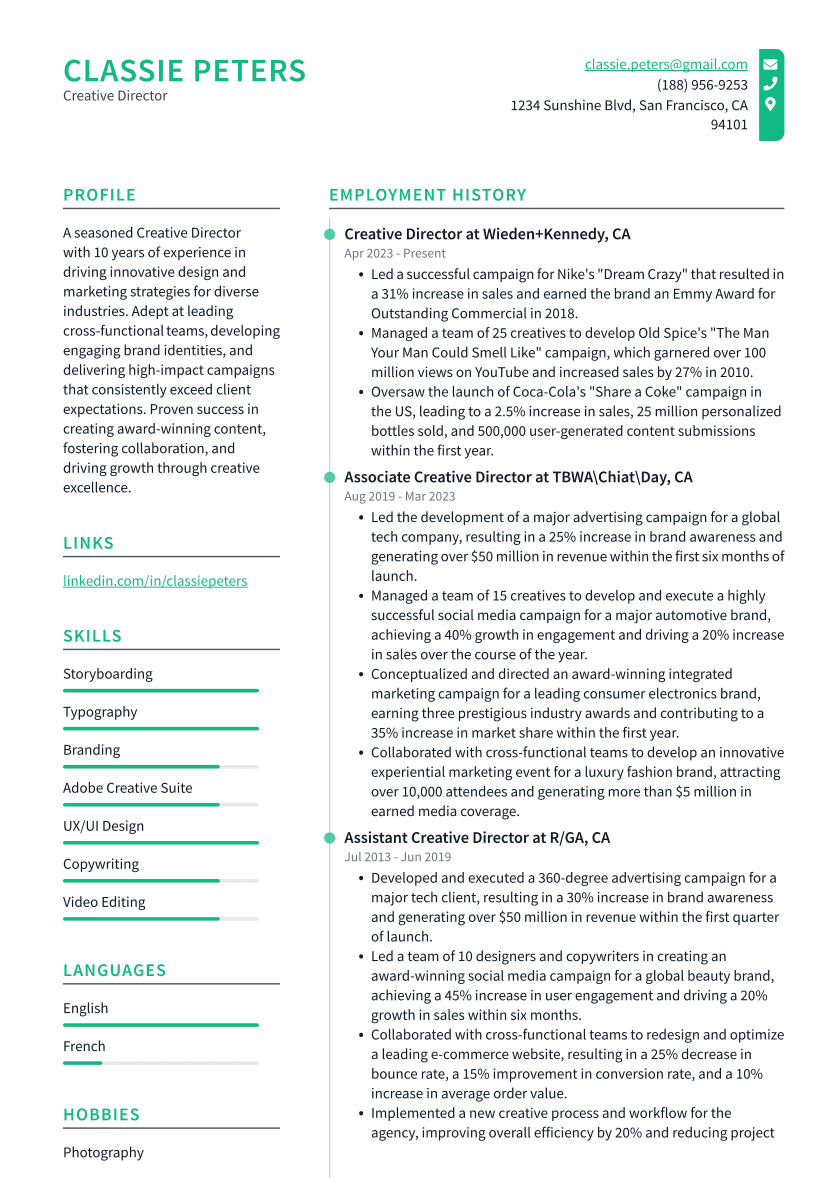Creative Director Resume Examples
Writing a great creative director resume is important because it is one of the first things a potential employer will see when they are considering you for a position. It is your opportunity to make a good first impression and sell yourself as the best candidate for the job.
Create your resume
Select from 7 professional resume templates
If you're looking for inspiration when it comes to drafting your own creative director resume, look no further than the samples below. These resumes will help you highlight your experience and qualifications in the most effective way possible, giving you the best chance of landing the creative director job you're after.
Essential Components of a Creative Director's Resume
A Creative Director's resume is a testament to their artistic prowess, leadership skills, and strategic thinking. It's a document that encapsulates their ability to transform concepts into tangible outcomes and lead a team to success. An effective resume must not only highlight creative talents but also demonstrate project management, motivational skills, and organizational contributions. Below, we delve into the critical elements that constitute a Creative Director's resume, discussing the significance of each and offering insights on how to optimize them to craft a compelling resume.
Contact Information
The "Contact Information" section is the gateway to your resume, providing essential details for potential employers to reach out to you. It should be prominently placed and easily readable.

Include your full name, professional title (such as Creative Director), current location, phone number, and a professional email address. If relevant, add links to your LinkedIn profile or online portfolio, which can be particularly advantageous for Creative Directors to showcase their work.
Ensure all information is accurate and up-to-date to avoid missing out on potential opportunities due to incorrect contact details.
Professional Summary or Objective Statement
The Professional Summary or Objective Statement is a concise yet impactful introduction to your career aspirations and professional highlights. It's often the first section recruiters engage with, so it must capture their interest.
This segment should succinctly present your key skills, experiences, and achievements that align with the responsibilities of a Creative Director. It's your chance to convey your leadership and creative vision, as well as your strategic approach to achieving business objectives.
An example of an objective statement might be: "Award-winning Creative Director with over a decade of experience in spearheading diverse teams to develop innovative marketing campaigns, seeking to leverage my expertise at XYZ company."
- Customize this section for each job application to reflect the specific requirements of the role.
- Avoid clichés and focus on what distinguishes you as a Creative Director and how you can add value to the prospective employer.
Related: Top Creative Director Resume Objective Examples
Core Competencies or Skills
Key Abilities or Skills:
The abilities or skills section is where you list the specific talents that qualify you for the Creative Director role. Tailor this section to each job by focusing on skills that are pertinent to the job description.
- Leadership and Team Coordination: Demonstrate your ability to lead and manage a diverse team, fostering a collaborative environment.
- Creativity and Originality: Highlight your capacity for innovative thinking and executing unique concepts.
- Project Oversight: Showcase your project management skills, including planning, organizing, and time management.
- Communication Abilities: Emphasize your proficiency in articulating ideas clearly to both team members and clients.
- Technical Expertise: Mention any necessary design software or technical skills relevant to the industry.
- Strategic Planning: Illustrate your strategic planning skills in aligning creative strategies with business objectives.
- Problem-Solving Abilities: Detail your ability to identify and resolve issues effectively.
- Industry Insight: Show your understanding of industry trends and marketing strategies.
- Budgeting Abilities: Highlight your competence in managing budgets without compromising quality.
- Client Relationships: Stress the importance of building strong client relationships and exceeding their expectations.
Provide examples in your professional experience section to illustrate these skills in action.
Related: Creative Director Skills: Definition and Examples
Work Experience and Achievements
The "Work Experience and Achievements" section is where you chronicle your professional journey, emphasizing the roles you've held, the projects you've managed, and the successes you've achieved.
List your work history in reverse chronological order, including job titles, company names, locations, and dates of employment. For each role, highlight responsibilities and accomplishments that demonstrate your leadership and creative capabilities.
Quantify your achievements with specific metrics, such as 'increased brand engagement by 30%' or 'led a team of 10 designers on a project that boosted revenue by 20%'. Also, mention any awards or recognitions received, as they serve as external endorsements of your skills.
This section should weave a narrative of your professional growth and consistent contributions, positioning you as the ideal candidate for the Creative Director role.
Education and Certifications
The "Education and Certifications" section outlines your academic background and any professional certifications that enhance your qualifications.
Most Creative Director positions require at least a bachelor's degree in fields such as marketing, graphic design, or communications. Include your degrees, institutions attended, and graduation dates. Highlight any relevant certifications from recognized organizations or additional training that pertains to creative direction.
While education and certifications are important, they should complement hands-on experience and proven creative and leadership skills to form a robust Creative Director resume.
Related: Creative Director Certifications
Portfolio of Creative Works
A portfolio is a powerful addition to a Creative Director's resume, offering a visual representation of your skills and experience. It should include diverse examples from your career, such as ad campaigns, branding initiatives, product designs, or digital media projects.
Provide a brief description for each portfolio item, detailing the project's objectives, your role, and any measurable outcomes. An online portfolio is often preferred for its accessibility and flexibility, allowing for the inclusion of various media formats.
Focus on quality over quantity, regularly updating your portfolio with your latest and most impressive work.
References or Testimonials
References and testimonials lend credibility to your resume by offering third-party validation of your skills and accomplishments.
Select references who can attest to your creative and leadership abilities, such as former supervisors, colleagues, or clients. Obtain their consent before listing them on your resume and ensure they are prepared to provide positive feedback.
Including a few powerful testimonials from previous employers or clients can also enhance your resume by highlighting specific achievements or praising your work.
Limit this section to two or three relevant references or testimonials that reinforce the skills and experiences highlighted in other parts of your resume.
Well-chosen references and compelling testimonials can significantly strengthen a Creative Director's resume, providing evidence of your professional capabilities and success.
